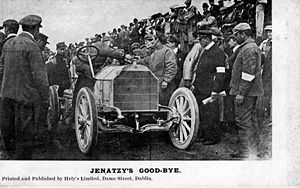DEVELOPMENT OF RACING FORMULAS

Regulations that divide cars into different categories and classes according to the type of drive, number of seats, weight, engine capacity etc.. were created simultaneously with the announcement of the first car races. Only there, where the rules exist, they may not be followed, fail to meet the conditions, possibly infringe them consciously or unconsciously. These practices go hand in hand with the development of motor racing regulations (later these rules came to be referred to as "racing formulas."”). Already before the first competition, which were actually just an advertising ride, cars had to undergo the so-called. qualifications, in which the participants had to show their skills, and the cars had to travel the distance 50 km in four hours. Only this qualification passed through the sieve 66 cars with 102 reported. There were also problems in determining the winner. Speed was not the condition of victory, but reliability, so that the first place had to be shared between the Panhard-Levassor, with four cars at the finish line and a Peugeot with five.
Ignorance of the rules has disappointed some of the talented players. Np. Emile Levassor, one of the first inventors of the automobile, known for its accuracy and diligence, he won after a tiring 49-hour drive in the Paris-Bordeaux-Paris race, however, he was disqualified, because he was driving a two-seat car, while the regulations stipulated the number of seats out of four. The rules of racing were often so complex and extensive, that today we are unable to objectively evaluate them. In the first races in America, in 1895 In addition to speed, fuel consumption was also assessed when determining the winner of the year on the Milwaukee-Chicago route, reliability and comfort of the car, and even its trading price. A bit of order in the classification of cars was introduced by the regulations of the French automobile club ACF z 1899 years that divide vehicles by weight into two categories: below 400 kilograms and above 400 kg. Later, the cars were additionally divided into the next two categories: below and above 600 kg. W 1902 In the year, the cars were divided into small ones according to French regulations (cart 250-400 kg), light (400-650 kg) and big (650-1000 kg). On the occasion of the first ACF Grand Prix in 1906 The year also saw the first proposals for racing rules called Formula Grand Prix:
1. Maximum car weight 1000 kg with the possibility of exceeding this weight by 7 kg if spark ignition is used.
2. Participation of a maximum of three riders from each car company.
3. Possibility to swap the driver's and co-passenger's seats. Mudguards, upholstery, horn, lamps and toolbox were not included in the weight of the car.
W 1907 of the year the Grand Prix formula was changed like this, that the only limitation was the maximum fuel consumption specified in 301/100 km. Virtually none of the racing car manufacturers were affected by this limitation. The first limitation on engine power was the Ostende Formula in force from 1908 year. It determined the maximum area of the pistons of the engine cylinders on 750 cm2, thus, for four-cylinder engines, there was a limitation of the cylinder diameter to 155 mm, and for six cylinder engines (Austin, Weigel) do 127 mm. Minimum allowable weight – 1100 kg – it was counted without fuel, water, tools, fenders and spare wheels. It was interesting, that the formula did not require the obligatory fitting of a horn. In years 1909-1911 admittedly, a formula for minimal weight cars was announced 900 kg, but the races did not take place due to the lack of interest from the producers. The prolonged disagreement on the Formula Grand Prix resulted in, that in 1912 of the year, the so-called. free formula with no limits on engine capacity and weight. Before the ACF Grand Prix races of the year 1913 the technical parameters of the formula cars were dealt with in more detail. Maximum weight limited to 1100 kg, and the minimum to 800 kg. The size and shape as well as the location of the fuel tank were also determined: it was to be in the shape of a cylinder with a length 1 m and be behind the driver. In the last pre-war formula, St. 1914 year, engine capacity was limited to 4500 cm3, and the compressor has been disallowed. Cars could have a maximum 1750 mm in width.
During World War I, Grand Prix races were held in America. American formula, taken over in 1921 years across Europe, lowered even the maximum engine capacity without supercharging to 3000 cm3. The tendency to lower the engine capacity was also manifested in the following years. From 1922 year, the so-called. two-liter formula, which lasted the entire four years. The power of the engines with the maximum capacity 2000 cm3 dropped to pre-war levels, therefore, the designers reached for the allowed top-up. The minimum weight has also been lowered to 650 kg, the weight of both competitors should be minimal 120 kg. An interesting limitation was the size of the rear part of the body, which should not protrude from the axle of the rear wheels by more than 1500 mm. From 1925 In the year, only one competitor - the driver - could drive the car.